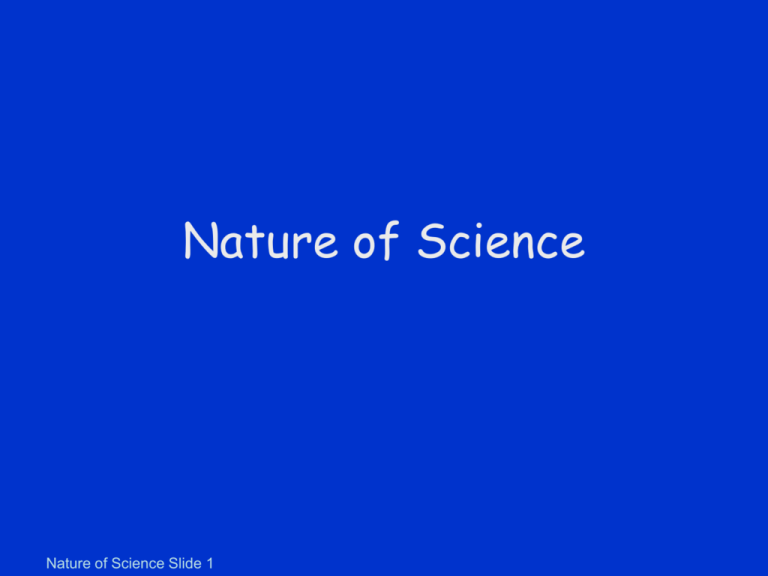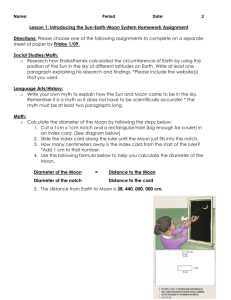Nature of Science
advertisement

Nature of Science Nature of Science Slide 1 Scientific Measurements “No amount of experimentation can ever prove me right; a single experiment can prove me wrong.” ~Albert Einstein Nature of Science: Slide 2 Size of Earth • Eratosthenes measured the size of the earth in 235 BC • Calculated the circumference of earth by comparing shadows at local noon Nature of Science : Slide 3 Eratosthenes’ Method • Determine angle between sun’s rays and vertical • This angle is equal to the angle between the two radius vectors • 7.1o/360o = 1/50 • Distance between Syene and Alexandria known to be 800 km • 50*800 km = 40,000 km Nature of Science : Slide 4 Size of the Moon • Aristarchus determined the size of the moon in 240 BC • Eclipse of moon • Shadow of earth at moon’s distance has tapered by 1 moon diameter • Shadow was 2.5 X the moon’s diameter Nature of Science: Slide 5 • Earth’s diameter is therefore 3.5 X moon’s diameter • Moon diameter = 2*6,370 km/3.5 = • 3640 km Distance to Moon • Once Aristarchus had estimated the diameter of the moon (to within 5% of the present accepted value) • the above technique was used to calculate the distance to the moon • 110*3640 km = 400,400 km Nature of Science: Slide 6 Distance to Sun • Once earth-moon distance is known • Right triangle trigonometry allows the determination of the earth-sun distance • Aristarchus measured the angle X to be 87o • Actual value is 89.8o (difficult to measure) • Sun is 400 X farther than moon • Aristarchus estimated 20 X earth-moon distance Nature of Science: Slide 7 Size of the Sun • • • • Nature of Science: Slide 8 Pinhole camera Sun’s diameter is 150,000,000 km/110 = 1,360,000 km Pinhole Camera Nature of Science: Slide 9 • Pinhole camera can be used to safely view a partial eclipse • Spaces between leaves act as pinholes during eclipse Science Terms • Fact – a close agreement by competent observers – facts can change • Hypothesis – must be stated in a way that it can be disproved • Theory – a synthesis of a large body of information encompassing well-tested and verified hypotheses Nature of Science: Slide 10 Scientific Hypotheses • Scientific Hypothesis – Must be testable – Must be falsifiable • Our universe is surrounded by another, larger universe, with which we can have absolutely no contact. – Not testable • There are other inhabited planets in the universe. – Not falsifiable • The moon is made of green cheese. – Testable & Falsifiable Nature of Science: Slide 11 Check Yourself • Which of these is a scientific hypothesis? – Atoms are the smallest particles of matter that exist. – Space is permeated with an essence that is undetectable. – Albert Einstein was the greatest physicist of the twentieth century. Physics 1052 Lecture 1 Slide 12 Check Yourself • Which of these is a scientific hypothesis? – Atoms are the smallest particles of matter that exist. – Space is permeated with an essence that is undetectable. – Albert Einstein was the greatest physicist of the twentieth century. Physics 1052 Lecture 1 Slide 13 Scientific Method • There are many scientific methods – but generally – Recognize a question – Form a testable hypothesis – Make predictions – Test predictions – Formulate simplest general rule Nature of Science: Slide 14







